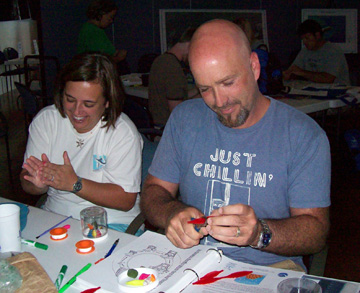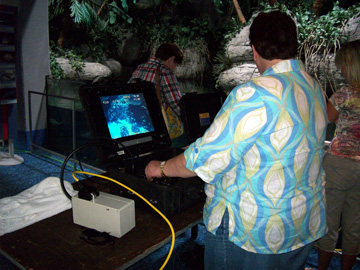PRESENTATIONS

Sanctuary staff and volunteers frequently exhibit or present educational information at conferences, community events, dive clubs, school functions, and more.
Some of the places you are likely to see us include:
- Conference for the Advancement of Science Teaching (CAST), the state science teacher conference
- Texas Dive Show, a recreational dive expo
- Earth Day events
- School Science Nights
- Dive Club meetings
To find out what we already have planned, please check the Calendar of Events.
For more information regarding specific events or to see about scheduling a presentation for your group, contact flowergarden@noaa.gov
If you'd like to volunteer to help us with events or presentations, please let us know.
top of page
WORKSHOPS

Flower Garden Banks National Marine Sanctuary offers a variety of professional development opportunities for teachers and is considered an approved provider by the Texas State Board of Educator Certification (SBEC).
Down Under, Out Yonder (DUOY)
Workshop & SCUBA Field Experience
 What are corals? How do they build reefs? Why are the coral reefs of the northwestern Gulf of Mexico so special and unique? What does all this have to do with the National Marine Sanctuary System?
What are corals? How do they build reefs? Why are the coral reefs of the northwestern Gulf of Mexico so special and unique? What does all this have to do with the National Marine Sanctuary System?
These are just a few of the questions that will be answered through this interactive, resource-rich 5-day workshop. Educators of all levels will walk away from the experience with the means to actively involve their students in the learning process, expose them to scientific research, and share personal experiences about the challenges of field work.
Participants will receive a multitude of resources, activities, materials, and ideas for implementation of topics in biology, oceanography, geology, physical science, American government and environmental science.

Teachers making coral spawning globes.
Photo: Drinnen/FGBNMS
The first 2 days of the workshop take place in Galveston, TX and cover much of the content listed above. REEF fish identification is also an integral part of the content. Educators will learn to identify approximately 80 species of reef fish, then practice what they've learned at the Aquarium at Moody Gardens.

Teachers gathered for discussion in the galley of the M/V Fling. Photo: Janene Fowler, DUOY 2007
The following 3 days are spent on a live-aboard dive boat in the Gulf of Mexico, visiting and diving in the sanctuary! Your reef fish knowledge will be put to use doing fish surveys that will actually contribute to an ongoing database of species and abundance in the sanctuary.

Teacher ready to dive.
Photo: Janene Fowler, DUOY 2007
This workshop is coordinated by the Gulf of Mexico Foundationand sponsored by ConocoPhillips, with most of the content provided by sanctuary staff.

Down Under, Out Yonder is usually offered once each year, in June or July. It generally provides participants with 28-30 hours of SBEC credit, depending on the exact activities included and the final schedule. Registration and information materials are available from the Gulf of Mexico Foundation web site beginning in January or February each year.
Participants need not work in a formal classroom setting, but must be involved in educating K-12 students or training personnel who educate K-12 students (e.g. aquariums, museums, nature preserves, youth organizations, home school cooperatives, etc.).
Participants must also be Scuba certified to participate in the field experience. We DO NOT provide Scuba instruction.
For non-divers, there is an option to participate in just the 2-day Galveston part of the workshop.
top of page
Science at Sea
This workshop is designed to introduce educators to the workings of a research vessel while involving them in a variety of scientific activities in nearshore and offshore environments.

Teachers operate an ROV at Stetson Bank. Photo: FGBNMS
Workshop participants will learn to identify phytoplankton and determine its significance in harmful algal blooms, conduct water quality sampling at the surface and up to 60 feet below, use a remotely operated vehicle to explore the sanctuary, and investigate the workings of the sanctuary research vessel.

Teachers pull plankton nets alongside the bulkhead at
Texas A&M University Galveston. Photo: FGBNMS
This workshop lasts five days. Three days are land-based and include skill development prior to offshore adventures as well as a time for tabulating results after sample collection. The other two days take place at sea, on board the R/V Manta, weather permitting.

Teacher practices operating an ROV in the South Pacific exhibit of the Aquarium at Moody Gardens. Photo: FGBNMS
Various discussions and activities are included to help evaluate what has been learned and how it might be applied in the classroom environment or incorporated into student field experiences.
In the case of uncooperative weather, alternative activities will be conducted, but we hope the participants will also gain an appreciation for the challenges of ocean exploration and research.
This workshop is expected to be available to applicants once each summer, in either June or July. For a taste of things to come, please see the report from our 2009 Science at Sea Teacher Cruise. You'll find a dialogue about our experiences and plenty of images to whet your appetite for adventure!
top of page